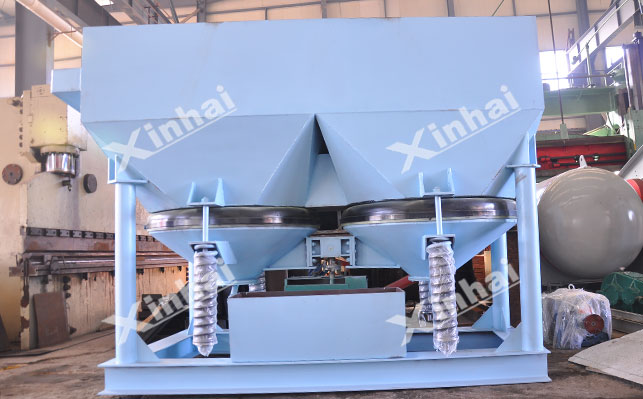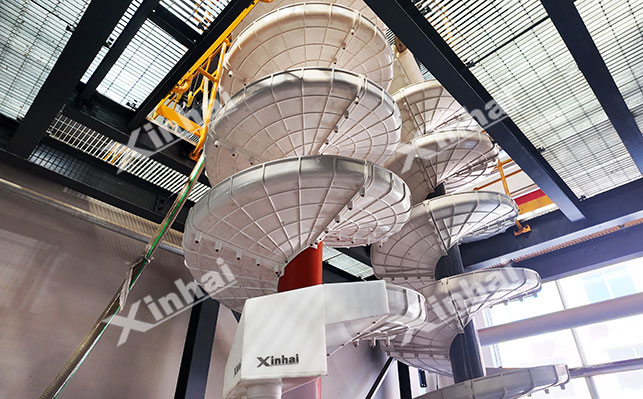
15311826613
Click to add WeChatManganese ore, as the primary raw material for the manganese industry, serves as a widely used desulfurizer and deoxidizer in steelmaking, a catalyst for manganese dioxide preparation in the chemical industry, and a crucial positive electrode material for zinc-manganese dry batteries in the energy sector. With the depletion of high-grade manganese ores, manganese oxide has emerged as the primary focus for development. The common manganese oxide minerals, namely pyrolusite, psilomelane, and hydromanganese, require specific processing approaches. Now, let's explore the manganese oxide beneficiation method applicable to these three types of manganese oxide ores!
Pyrolusite is a weathered manganese oxide ore, which is often closely associated with pyrolusite, hydromanganese and clay minerals. The embedded particle size ranges from coarse particles (above 1mm) to fine particles (below 0.01mm). Especially in weathered manganese oxide ores, it is often wrapped in clay minerals in the form of cement, which is difficult to dissociate. For this type of manganese ore dressing, a combined method is often used.
Ore washing-gravity separation: Before gravity separation, the ore is washed and impurities are removed to avoid mud interference with subsequent separation, and then the ore is graded through a vibrating screen. During gravity separation, the coarser particles (8-30mm) enter the jig for rough separation, and the fine particles (0-3mm) are finely separated by a shaking table, and finally a manganese concentrate is obtained.

Ore washing-strong magnetic separation: This process is also first washed to remove a large amount of mud-containing impurities, and then the ore particles are ground to -0.074mm by a ball mill, accounting for about 70%, so that the sclerophyllous ore monomers are fully dissociated, and then a high gradient magnetic separator or a strong magnetic separator is used to use the weak magnetic properties of the sclerophyllous ore for magnetic separation and separation from non-magnetic gangue.
Washing-gravity separation-magnetic separation-flotation: It is mostly suitable for hard manganese ores with complex composition and uneven distribution of particle size. First, wash and desludging are carried out, then a large amount of waste rock is discarded by gravity separation, and magnetic separation is further enriched. Then flotation is used to improve the quality of the final concentrate. Generally, flotation will use specific collectors such as fatty acids to remove residual silicate and other gangue minerals.
Pyrolusite is a low-valent manganese compound that is oxidized to manganese dioxide and gradually enriched to form pyrolusite. Its theoretical manganese content is 63.19%. The crystal structure belongs to the tetragonal system. Under ideal conditions, the crystals are needle-shaped or columnar, but complete crystals are rare in nature. They are mostly produced in block, granular, and powder aggregates. Common beneficiation methods for this type of minerals are mainly gravity separation, magnetic separation and flotation.
Gravity separation method: It is suitable for processing coarse-grained (particle size>0.2mm) pyrolusite, and gravity separation is completed through spiral chutes and jigs. Among them, the chute gravity separation uses the combined force of centrifugal force, gravity and water flow to separate manganese from gangue; the jigging gravity separation uses periodic pulsating water flow to separate the ore particles according to density.

Magnetic separation-flotation: Use a strong magnetic separator or a high gradient magnetic separator to capture weakly magnetic pyrolusite under strong magnetic field conditions, and then further purify it through flotation. The anion collector is used to react with the metal ions on the surface of the pyrolusite to achieve capture; the cationic collector is adsorbed by electrostatic action. At the same time, the adjustment agent and activator are added to enhance the surface activity of the pyrolusite, and finally a manganese concentrate is obtained.
Gravity separation-magnetic separation-flotation: suitable for pyrolusite with complex composition and variable properties. First, a large amount of tailings are removed by gravity separation to remove the gangue minerals with low density; then a strong magnetic separator is used for further enrichment; the magnetic concentrate is then removed by flotation to remove residual impurities, and finally a high-grade manganese concentrate is obtained.
Washing-magnetic separation-flotation: suitable for pyrolusite with high mud content. First, it is washed by a drum or trough ore washer to remove mud impurities, and then magnetic separation is carried out for enrichment and flotation purification.
Manganese ore is formed in an environment with weak oxidation. It is the product of the transition from primary manganese ore to oxidized manganese ore. It often coexists with hard manganese ore and pyrolusite. When this type of manganese ore is heated to 100-200℃, it will lose crystal water and turn into pyrolusite. In addition, due to its low hardness, over-crushing is prone to occur during the ore dressing process, so the problem of over-crushing needs to be avoided.

Crushing: A multi-stage crushing and stage grinding process is often used. Use a jaw crusher for coarse crushing, a cone crusher for medium crushing, and a ball mill for grinding. The particle size control range is generally -0.074mm, accounting for 60%-70%.
Gravity separation: Mainly used for the preliminary enrichment of manganite. The fine-grained materials are separated by a shaking table, and manganite with a particle size of 0.04-2mm can be effectively recovered.
Magnetic separation-flotation: Suitable for fine-grained manganite, first use a strong magnetic separator (magnetic field strength 1.0-1.5T) to capture fine manganite particles to achieve separation from non-magnetic gangue; then flotation is used for deep purification. By adding selective collectors and regulators and adjusting the pH value to 9-10, manganite and gangue can be effectively separated.
Roasting-magnetic separation-flotation: Since manganite contains crystal water in its structure, it is first roasted at 150-200℃ to remove its crystal water and convert it into pyrolusite, and then enriched by magnetic separation and purified by flotation to finally achieve manganese concentrate recovery.
The above is an introduction to the beneficiation methods of three types of manganese oxide ores. In actual situations, due to the differences in theoretical manganese content and their own characteristics, the selection of beneficiation methods for pyrolusite, pyrolusite and manganese ore needs to be "adapted to local conditions". It is recommended to conduct beneficiation tests on the ore first, and design a suitable manganese ore beneficiation plan based on the test analysis.